‘Seth Klarman Margin Of Safety’ PDF Quick download link is given at the bottom of this article. You can see the PDF demo, size of the PDF, page numbers, and direct download Free PDF of ‘Margin Of Safety’ using the download button.
Margin Of Safety Risk-Averse Value Investing Strategies Book PDF Free Download

Speculators And Unsuccessful Investors
Investing Versus Speculation Mark Twain said that there are two times in a man’s life when he should not speculate: when he can’t afford it and when he can.
Because this is so, understanding the difference between investment and speculation is the first step in achieving investment success.
To investors, stocks represent fractional ownership of underlying businesses and bonds are
loans to those businesses.
Investors make buy and sell decisions on the basis of the current prices of securities compared with the perceived values of those securities.
They transact when they think they know something that others don’t know, don’t care about, or prefer to ignore.
They buy securities that appear to offer attractive returns for the risk incurred and sell when the return no longer justifies the risk.
Investors believe that over the long run security prices tend to reflect fundamental developments involving the underlying businesses.
Investors in stock thus expect to profit in at least one of three possible ways: from free cash flow generated by the underlying business, which eventually will be reflected in a higher share price or distributed as dividends; from an increase in the multiple that investors are willing to pay for the underlying business as reflected in a higher share price; or by a narrowing of the gap between share price and underlying business value.
Speculators, by contrast, buy and sell securities based on whether they believe those
securities will next rise or fall in price.
Their judgment regarding future price movements is based, not on fundamentals, but on a prediction of the behavior of others.
They regard securities as pieces of paper to be swapped back and forth and are generally ignorant of or indifferent to investment fundamentals.
They buy securities because they “act” well and sell when they don’t.
Indeed, even if it were certain that the world would end tomorrow, it is likely that some speculators would continue to trade securities based on what they thought the market would do today.
Speculators are obsessed with predicting—guessing—the direction of stock prices.
Every morning on cable television, every afternoon on the stock market report, and every weekend in Barron’s, every week in dozens of market newsletters, and whenever businesspeople get together, there is rampant conjecture on where the market is heading.
Many speculators attempt to predict the market direction by using technical analysis— past stock price fluctuations as a guide.
Technical analysis is based on the presumption that past share price meanderings, rather than
underlying business value, hold the key to future stock prices.
In reality, no one knows what the market will do; trying to predict it is a waste of time, and investing based on that prediction is a speculative undertaking.
Market participants do not wear badges that identify them as investors or speculators.
It is sometimes difficult to tell the two apart without studying their behavior at length.
Examining what they own is not a giveaway, for any security can be owned by investors, speculators, or both.
Indeed, many “investment professionals” actually perform as speculators much of the time because of the way they define their mission, pursuing short-term trading profits from predictions
of market fluctuations rather than long-term investment profits based on business fundamentals.
As we shall see, investors have a reasonable chance of achieving long-term investment success; speculators, by contrast, are likely to lose money over time.
There is the old story about the market craze in sardine trading when the sardines disappeared
from their traditional waters in Monterey, California.
The commodity traders bid them up and the price of a can of sardines soared. One day a buyer decided to treat himself to an expensive meal and actually opened a can and started eating.
He immediately became ill and told the seller the sardines were no good. The seller said, “You don’t understand. These are not eating sardines, they are trading sardines.”
| Author | Seth A. Klarman |
| Language | English |
| No. of Pages | 257 |
| PDF Size | 15 MB |
| Category | Business |
| Source/Credits | ia803402.us.archive.org |
Margin Of Safety Risk-Averse Value Investing Strategies Book PDF Free Download
